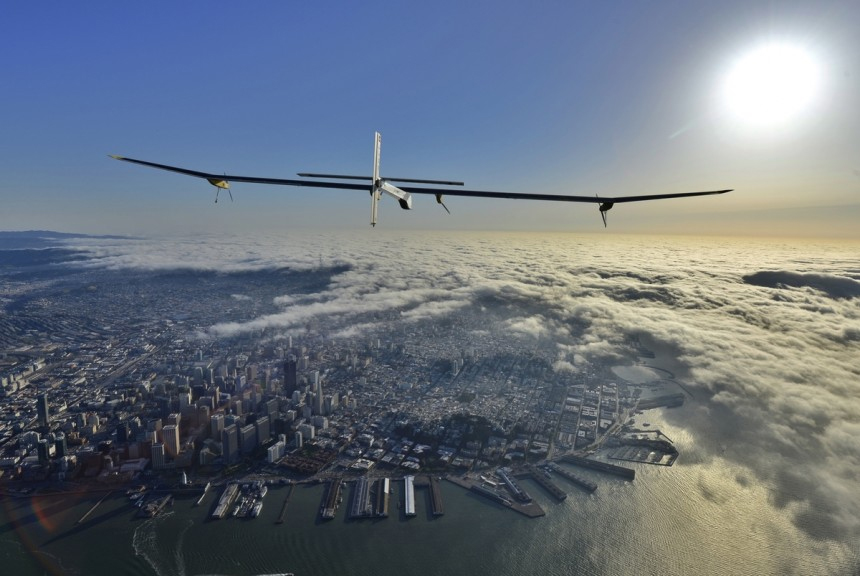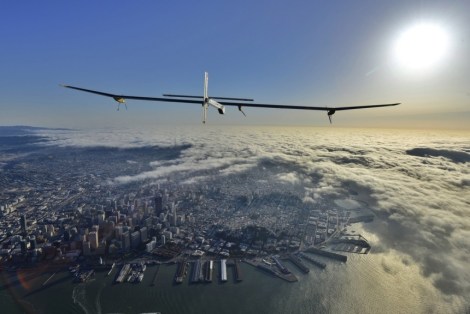Standing beside Solar Impulse — the world’s most advanced solar aircraft — in a hangar at the Phoenix Sky Harbor International Airport on a recent afternoon, Bertrand Piccard attempted to diagnose humankind’s biggest problem.
We are being bored to death, he opined.
“People talk about protecting the environment and it’s boring,” the 53-year-old Swiss aviator/psychiatrist said. Discussions about climate change are even worse. “Those,” he added, “are boring and depressing.”
Piccard’s prescription: Make environmentalism inspiring, exciting, and sexy. Not coincidentally, those adjectives are frequently used to describe Solar Impulse itself, the aircraft Piccard piloted 650 miles, from Mountain View, Calif., to Phoenix, Ariz., on May 3, the first of five legs in a coast-to-coast voyage.
“We want to motivate people to be pioneers,” said Piccard, stressing the syllable with the intensity of a hypnotist (which he is). “We want to show solutions. To show hopes. We want to show what is possible.”
Not long ago, the notion that a solar-powered aircraft could stay aloft day and night did, in fact, seem impossible. But in 2010, Solar Impulse broke this technological barrier when the plane flew for a record 26 consecutive hours. After reaching an altitude of nearly 28,000 feet, the aircraft, then piloted by André Borschberg (CEO and cofounder, along with Piccard, of the Solar Impulse project), descended slowly, landing an hour before dawn. The plane’s lithium polymer batteries had enough power left to fly for an additional six hours.
Solar Impulse has the wingspan of Boeing 747 but weighs only as much as a Subaru Outback. With a bulbous cockpit affixed to a fuselage just two feet wide, the Swiss-built aircraft looks like one of the many dragonflies that buzz around outside the hanger in the Sonoran desert during the Arizona stopover. Nearly 12,000 solar cells, each as thin as a human hair, cover the top of the plane’s upward curving wings and its horizontal stabilizers. Four electric motors provide roughly the same amount of energy to the Solar Impulse as the Wright brothers’ gasoline-powered engine produced for the world’s first flight.
On that historic occasion, the Wright Flyer 1 flew 120 feet at just under seven miles per hour. Solar Impulse is no racer either — it has a top speed of just 43 miles an hour. But speed is as irrelevant to the significance of Solar Impulse as it was to the Wright brothers’ invention.
“In 1903,” said Piccard, “nobody could imagine that there could be 200 people crossing the oceans in big airliners. The goal today with Solar Impulse isn’t to replace airliners with solar airplanes. It is to demonstrate clean technologies. We don’t carry passengers. We carry a message.”
While Solar Impulse was still in the air on its way to Phoenix, Borschberg shared his version of that message in a phone conversation.
“What we are doing in the air, people can do on the ground,” the former Swiss Air Force pilot explained.
It’s a point the pair make repeatedly, both in interviews and at the public events they attend during the trip.
Soon after arriving in Phoenix, for example, Piccard and Borschberg addressed a class of graduating engineers at the Arizona State University commencement.
“The world needs you to invent new solutions in order to invent another future,” Piccard told the audience of 10,000 graduates and their families. “It’s technical and non-technical. It’s about fighting poverty. It’s about human rights. It’s about globalization. But of course it is a lot about energy, sustainability, and clean technologies that the future needs to have a brighter world.”
From Phoenix, Solar Impulse is flying to Dallas-Fort Worth and then on to St. Louis and Washington, D.C., before arriving at its final destination, New York’s John F. Kennedy International Airport, in mid-July.





